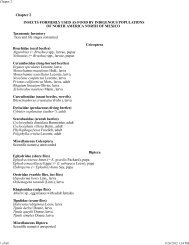Helminthosporium Turf Diseases - Russell Labs Site Hosting
Helminthosporium Turf Diseases - Russell Labs Site Hosting
Helminthosporium Turf Diseases - Russell Labs Site Hosting
- No tags were found...
You also want an ePaper? Increase the reach of your titles
YUMPU automatically turns print PDFs into web optimized ePapers that Google loves.
XHT1150Provided to you by:University of Wisconsin Garden FactsRevisedMar. 18, 2008<strong>Helminthosporium</strong> <strong>Turf</strong> <strong>Diseases</strong>Hye Sook Kim* and Brian Hudelson, UW-Plant PathologyGeunhwa Jung, University of Massachusetts Amherst-Plant, Soil and Insect SciencesWhat are <strong>Helminthosporium</strong> turf diseases? <strong>Helminthosporium</strong> diseases of turf are agroup of common, cool season turfgrass diseases (including <strong>Helminthosporium</strong> leaf spot and meltingout) that occur throughout North America. In residential settings, these diseases can severely reducethe aesthetic appeal of a lawn and can lead to expensive lawn replacements.What do <strong>Helminthosporium</strong> turfdiseases look like? Symptoms of<strong>Helminthosporium</strong> turf diseases vary, dependingupon the specific pathogen, grass species,weather conditions, and cultural conditionsinvolved. In general, the diseases lead to patchesof thin, dead grass. On Kentucky bluegrass, andfine and tall fescues, initial symptoms are small,dark purple to black spots on the leaf blades.Older leaf spots on these hosts are oftendescribed as “eyespots” (i.e., round to oval spotswith buff-colored centers surrounded by darkbrown to dark purple margins). Infectedbentgrasses often initially have a smoky-blue,water-soaked and matted appearance. As thedisease progresses, infected leaves yellow andeventually die.<strong>Helminthosporium</strong> turf diseases cause“eyespots”, round to oval spots with buffcoloredcenters surrounded by darkbrown to dark purple margins.Where do <strong>Helminthosporium</strong> turfdiseases come from? <strong>Helminthosporium</strong>turf diseases are caused by several fungi, all ofwhich were at one time lumped within the fungalgenus <strong>Helminthosporium</strong>. More recently, thesefungi have been reclassified into the generaBipolaris, Drechslera, and Exserohilum. Thesefungi overwinter in infected turfgrass and turfgrass debris (e.g., thatch, grass clippings), andthroughout the growing season produce spores that can readily infect leaf blades that have been wetfor several hours. Disease development is favored during periods of high temperature when dryconditions alternate with prolonged stretches of cloudy, moist weather.How do I save turf with <strong>Helminthosporium</strong> turf diseases? Fungicides containingazoxystrobin, captan, chlorothalonil, fludioxonil, fluoxastrobin, iprodione, maneb, mancozeb,myclobutanil, PCNB, polyoxin D, propiconazole, pyraclostrobin, thiophanate-methyl, trifloxystrobin,thiram and vinclozolin are labeled for control of <strong>Helminthosporium</strong> turf diseases. These fungicideswill not cure existing infections, but if they are applied early in disease development, may helpprevent substantial losses. If you decide to use fungicides for control, be sure to read and follow alllabel instructions of the fungicide that you select to ensure that you use the fungicide in the safest andmost effective manner possible.<strong>Helminthosporium</strong> turf diseases throughout the year+ +++ +++ +++ +++ +++ +++ +Jan Feb Mar Apr May June July Aug Sept Oct Nov DecLikelihood of disease: + = possible +++ = likely
University of Wisconsin Garden FactsHow do I avoid problems with <strong>Helminthosporium</strong> turf diseases in the future?Water, fertilize and mow your lawn properly (see UW-Extension bulletin A3435 for details) to keep ithealthy, and growing vigorously. <strong>Turf</strong> requires approximately one inch of water per week from naturalrain, supplemental irrigation or a combination of both. If you must irrigate, make sure to water deeply,but infrequently to avoid drought. Avoid lateafternoon and evening watering that can promotelonger periods of moisture on leaves. DO NOToverfertilize. In particular, avoid heavyapplications of nitrogen (especially fast-releasingforms of nitrogen such as urea), particularlyduring wet weather. Test leaf tissue from yourturf routinely to make sure that the nitrogen topotassium ratio (N:K) is approximately 1:2, andfertilize appropriately to maintain this ratio. Keepyour lawn mowed to between 2½ and 3½ inches,and never remove more than ⅓ of the existinggrowth when mowing. Keep the blade on yourmower sharp. Ragged cuts, caused by dullmower blades, provide easier entry points for<strong>Helminthosporium</strong> turf disease fungi. Collect anddestroy (by composting, burying or burning) lawnclippings from infected plants and try to clean anycontaminated clippings from your mower.<strong>Helminthosporium</strong> turf disease fungi can survive<strong>Helminthosporium</strong> turf diseases causedead patches on intensively managedcreeping bentgrass.and can easily be moved from place to place ingrass clippings. If <strong>Helminthosporium</strong> turfdiseases have been a problem in your lawn,consider using a blend of resistant turfgrasscultivars or a mixture of cool-season turfgrasseswhen establishing a new lawn or over-seeding an existing lawn. Resistant cultivars of Kentuckybluegrass include ‘Alpine’, ‘America’, ‘Boutique’, ‘Brilliant’, ‘Buckingham’, ‘Freedom II’, ‘Merion’,‘Moonlight’, ‘Serene’, and ‘Unique’ (see UW-Extension bulletin A3187 for details).In summary, to avoid problems with <strong>Helminthosporium</strong> turf diseases:• Reduce leaf wetness (June to Sept.)• Avoid drought stress (July, Aug.)• Avoid excess N (May to Aug)• Balance fertility (N:K = 1:2) (Spring, Fall)• Mow at 2½ to 3½ in. (May to Nov.)• Keep mower blades sharp (May to Nov.)• Avoid mowing wet grass (May to Nov.)• Collect diseased clippings (Spring)• Plant resistant turf cultivars (Fall)• Follow fungicide label (Always)For more information on <strong>Helminthosporium</strong> turf diseases: See UW-ExtensionBulletin A3187 or contact your county Extension agent.© 2008 by the Board of Regents of the University of Wisconsin System doing business as the division of Cooperative Extension of the University of Wisconsin Extension.*Completed as partial fulfillment of the requirements for the graduate course: “Plant Pathology 559: <strong>Diseases</strong> of Economic Crops.”An EEO/Affirmative Action employer, University of Wisconsin Extension provides equal opportunities in employment and programming, including Title IX and ADA requirements. This document can beprovided in an alternative format by calling Brian Hudelson at (608) 262-2863 (711 for Wisconsin Relay).References to pesticide products in this publication are for your convenience and are not an endorsement or criticism of one product over similar products. You are responsible for using pesticidesaccording to the manufacturer’s current label directions. Follow directions exactly to protect the environment and people from pesticide exposure. Failure to do so violates the law.Thanks to Diana Alfuth, Judy Reith-Rozelle and Deb Simons for reviewing this document.A complete inventory of University of Wisconsin Garden Facts is available at the University of Wisconsin-Extension Horticulture website: wihort.uwex.edu.
















